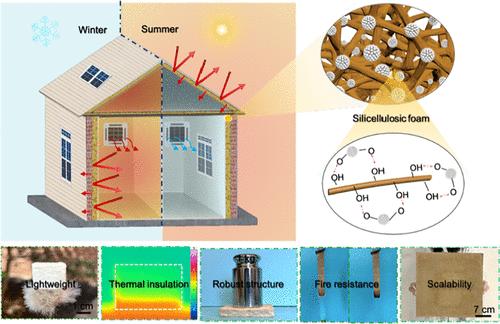分层生物基绝热泡沫
IF 16
1区 材料科学
Q1 CHEMISTRY, MULTIDISCIPLINARY
引用次数: 0
摘要
生物基泡沫塑料以其可持续和环保的特性而闻名,是一种有前途的隔热材料,具有显著提高建筑应用的能源效率和可持续性的潜力。然而,其相对较高的导热性、大孔结构和能源密集型制造工艺阻碍了其广泛应用。在这里,我们报道了一种可扩展的、一锅合成生物泡沫的方法,该方法通过整合再生纸浆和原位纳米孔二氧化硅形成,从而产生由微孔和纳米孔组成的分层结构。环境溶剂交换干燥可以通过减少干燥过程中的毛细力来保持孔隙结构。所制得的阻燃疏水泡沫具有低密度(0.110 g/cm3)、理想孔隙率(70.69%)、优异的导热性(0.033 W/(m·K))和优异的抗压强度(80%应变时1.48 MPa)。这种可回收的生物泡沫具有分层孔隙结构和环境耐久性,在节能建筑应用中显示出巨大的潜力。本文章由计算机程序翻译,如有差异,请以英文原文为准。

Hierarchical Biogenic-Based Thermal Insulation Foam
Biogenic-based foam, renowned for its sustainable and eco-friendly properties, is emerging as a promising thermal insulating material with the potential to significantly enhance energy efficiency and sustainability in building applications. However, its relatively high thermal conductivity, large-pore configurations, and energy-intensive manufacturing processes hinder its widespread use. Here, we report on the scalable, one-pot synthesis of biogenic foams achieved by integrating recycled paper pulp and in situ nanoporous silica formation, resulting in a hierarchical structure comprising both micropores and nanopores. Ambient solvent-exchange drying can preserve the pore structure by reducing the capillary forces during the drying process. The resulting flame-retardant and hydrophobic foam exhibits low density (0.110 g/cm3), ideal porosity (70.69%), excellent thermal conductivity (0.033 W/(m·K)), and impressive compressive strength (1.48 MPa at 80% strain). This recyclable biogenic foam, with its hierarchical pore structure and environmental durability, shows great potential for energy-efficient building applications.
求助全文
通过发布文献求助,成功后即可免费获取论文全文。
去求助
来源期刊

ACS Nano
工程技术-材料科学:综合
CiteScore
26.00
自引率
4.10%
发文量
1627
审稿时长
1.7 months
期刊介绍:
ACS Nano, published monthly, serves as an international forum for comprehensive articles on nanoscience and nanotechnology research at the intersections of chemistry, biology, materials science, physics, and engineering. The journal fosters communication among scientists in these communities, facilitating collaboration, new research opportunities, and advancements through discoveries. ACS Nano covers synthesis, assembly, characterization, theory, and simulation of nanostructures, nanobiotechnology, nanofabrication, methods and tools for nanoscience and nanotechnology, and self- and directed-assembly. Alongside original research articles, it offers thorough reviews, perspectives on cutting-edge research, and discussions envisioning the future of nanoscience and nanotechnology.
 求助内容:
求助内容: 应助结果提醒方式:
应助结果提醒方式:


